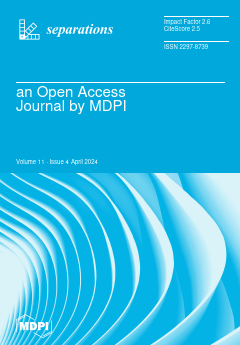Polyvinylidene fluoride (PVDF) membranes were coated with TiO
2 and TiO
2-Ag to enhance their efficiency for oil-in-water emulsion separation. The photocatalytic activities of the two modified membranes and their filtration performances were compared in detail. The significantly enhanced photocatalytic activity of the TiO
2-Ag composite was proved using a methyl orange (MO) solution (c = 10
−5 M) and a crude oil emulsion (c = 50 mg·L
−1). The TiO
2-Ag-coated membrane reduced the MO concentration by 87%, whereas the TiO
2-modified membrane reached only a 46% decomposition. The photocatalytic reduction in the chemical oxygen demand of the emulsion was also ~50% higher using the TiO
2-Ag-coated membrane compared to that of the TiO
2-coated membrane. The photoluminescence measurements demonstrated a reduced electron/hole recombination, achieved by the Ag nanoparticle addition (TiO
2-Ag), which also explained the enhanced photocatalytic activity. A significant improvement in the oil separation performance with the TiO
2-Ag-coated membrane was also demonstrated: a substantial increase in the flux and flux recovery ratio (up to 92.4%) was achieved, together with a notable reduction in the flux decay ratio and the irreversible filtration resistance. Furthermore, the purification efficiency was also enhanced (achieving 98.5% and 99.9% COD and turbidity reductions, respectively). Contact angle, zeta potential, scanning electron microscopy (SEM), and atomic force microscopy (AFM) measurements were carried out to explain the results. SEM and AFM images revealed that on the TiO
2-Ag-coated membrane, a less aggregated, more continuous, homogeneous, and smoother nanolayer was formed due to the ~50% more negative zeta potential of the TiO
2-Ag nanocomposite compared to that of the TiO
2. In summary, via Ag addition, a sufficiently hydrophilic, beneficially negatively charged, and homogeneous TiO
2-Ag-coated PVDF membrane surface was achieved, which resulted in the presented advantageous filtration properties beyond the photocatalytic activity enhancement.
Full article





